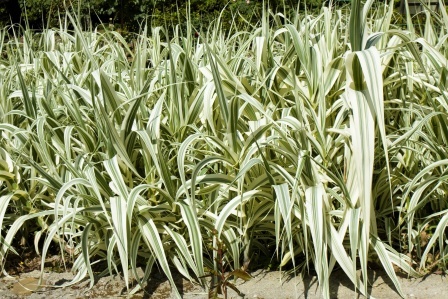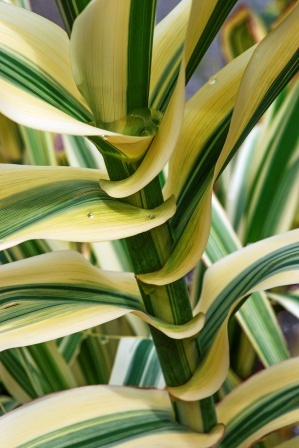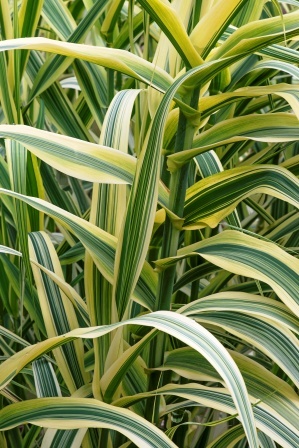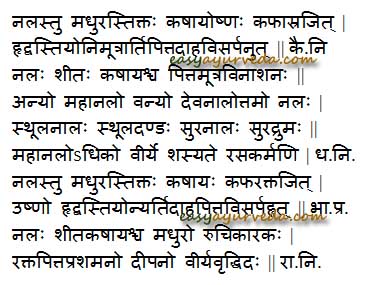Giant Reed Arundo donax Uses, Research, Remedies, Side Effects
Nala- Arundo donax is an Ayurvedic grass, mentioned for the treatment of burning sensation of body, herpes, improvement of breast milk in lactating women, skin diseases and in conditions of burning urination.
Latin name – Arundo donax Linn., Arundo donax variegata
Family – Poaceae (yava kula)

Table of Contents
Vernacular names
Names in different languages:
Hindi name – Narakata
English name – Great reed
Bengali, Gujarati and Marathi name – Nala
Sanskrit Synonyms
Randhra Patra, Randhri, Chidrantra, Kukshi Randhra, Sushira, Shoonyamadhya- The plant is hollow in the middle
Mrudu Cchada, Mrudupatra – leaves are soft and tender to touch
Dhamana, Potagala, Pota, Pito, Nata, Mrutyupushpa
Vibhishana, Nartaka, Nala, Nada, Keechaka, Vamshantara

Morphology
Morphology of Arundo donax:
Nala is a herb growing to a height of 2-4 meters. The stem of the plant resembles that of sugarcane with pale yellow color and is hollow inside. The leaves resemble that of a bamboo plant, 1-2 feet in length and 1-2 inches wide and hair like structures at the base. The flower stalk is 1-2 foot long, pale brown colored. Seeds are flat and oval. The plant is found all over India in the hilly regions.
Properties, part used, dosage
Medicinal properties of Giant Reed:
Rasa (Taste) – Madhura (Sweet), Kashaya (Astringent), Tikta (Bitter)
Guna (Qualities) – Laghu (Light for digestion), Snigdha (Slimy in nature)
Vipaka – Madhura (Undergoes sweet taste after digestion)
Veerya (Potency) – Sheeta (Cold)
Karma (Actions) – Vatapitta shamaka (reduces vitiated vata and pitta dosha)
Part used- Root
Dosage-
Decoction- 50 to 100 ml

Chemical composition
Chemical composition of Arundo donax:
The rhizome of the plant yields indole alkyl amine bases, including bufotenidine and dehydro-bufontenine. The leaves yield sterols and triterpenoids.
Uses of Nala
- The paste of the root of nala is applied over the area of the skin affected with herpes and eczema.
- The decoction of the root of Arundo donax is given in a dose of 50-100 ml to treat conditions of low sperm count and burning sensation of the body.
- The root of nala is boiled in cow milk and given in a dose of 100 ml to improve breast milk quantity in lactating women.
- Cold infusion of the root of Arundo donax is given in a dose of 50 ml to treat burning micturition and dysuria.
- The paste of the root is mixed with paste of neem leaf and applied over the wound as part of treatment.
Sanskrit verse

Indications
Traditional uses:
Asrajit – useful in blood disorders such as abscess, skin disorders, bleeding disorders such as menorrhagia, nasal bleeding etc.
Indicated in –
Hrut arti – cardiac pain
Vasti Shoola – abdominal colic pain, bladder pain
Yoni shoola – vaginal pain
Mutrakrichra –Dysuria, urinary retention
Daha – burning sensation, as in gastritis, neuropathy, burning sensation in eyes etc
Visarpa – herpes
Adverse effect
No adverse effect is known or reported after the use of Nala.
Interaction with medicines, supplements
Can this be used while taking Homeopathic medicine?
Yes. This product does not react with homeopathic medicine.
Can this medicine be continued while taking supplements like multivitamin tablets, Omega 3 fatty acids etc?
Yes. Generally, this product goes well with most dietary supplements. However, if you are taking more than one product per day, please consult your doctor for an opinion.
With western
medicines
Seek your
doctor’s advice if you are taking this product along with other western
(allopathic / modern) medicines. Some Ayurvedic herbs can interact with modern
medicine.
If both Ayurvedic and allopathic medicines are advised together, then it is
best to take Allopathic medicine first, wait for 30 minutes and then take the
Ayurvedic medicine.
Ayurvedic medicines
Ayurvedic medicines containing Nala:
Virataradi kashaya: It is a herbal decoction formulation, used in the treatment of urinary calculi, retention of urine and abdominal pain.
Varieties
Dhanvantari Nighantu mentions two types.
Nala and Maha Nala.
Classical categorization
Sushruta Samhita – Trinapanchamoola – Group of five grasses.
Astanga sangraha – Viratarvadi ganas
Bhavaprakasha – Guduchyadi varga
Dhanvantari Nighantu – Karaveeradi varga
Kaiyyadeva Nighantu – Oushadhi varga
Raja Nighantu – Shalmalyadi varga
Scientific classification
Kingdom: Plantae
Order: Poales
Family: Poaceae
Genus: Arundo
Species: A. donax
Author: Dr.B.K.Prashanth M.D (Ayu), Ph.D
E mail: [email protected]
Click to consult Dr Prashanth BK
Sthanika Karma (Systemic Action)
External Application – It has wound healing action. relieves burning sensation. Indicated in skin conditions like Erycyphalis
Internal administration-
Nervous system – Indicated in Insanity, Epilepsy, and in other convulsive disorders.
Circulatory System – Styptic, and acts as a blood purifier. indicated in Bleeding disorders
Reproductive system – Indicated in Leukorrhea, Menorrhagia, Metrorrhagia etc. Decoction is indicated for internal administration as well as for uttarabasti.
Excretory system – It is indicated in Dysuria, Helps to increase urine output
Tapakrama – Reduces burning sensation
Tvak – Indicated in skin disorders










